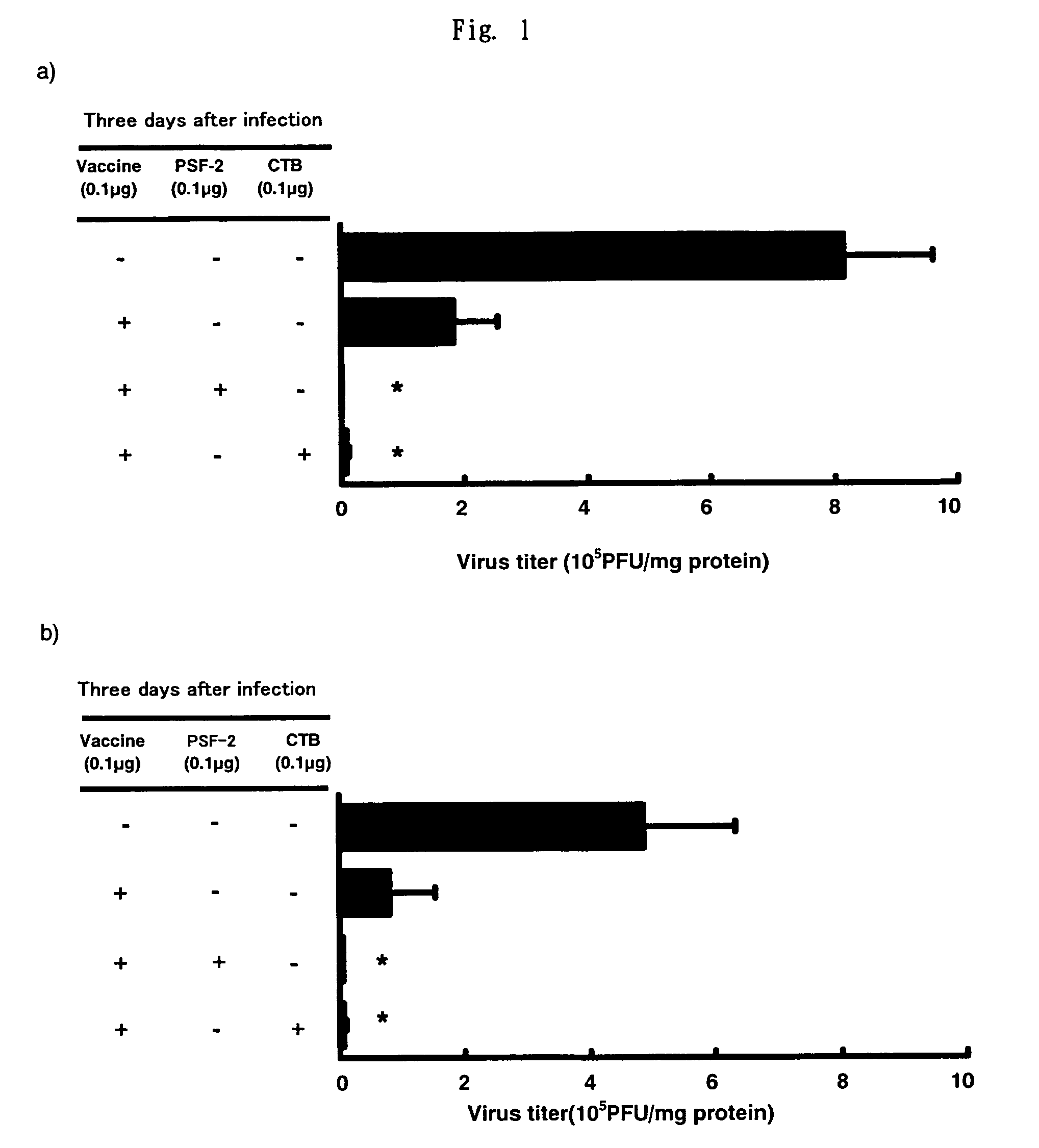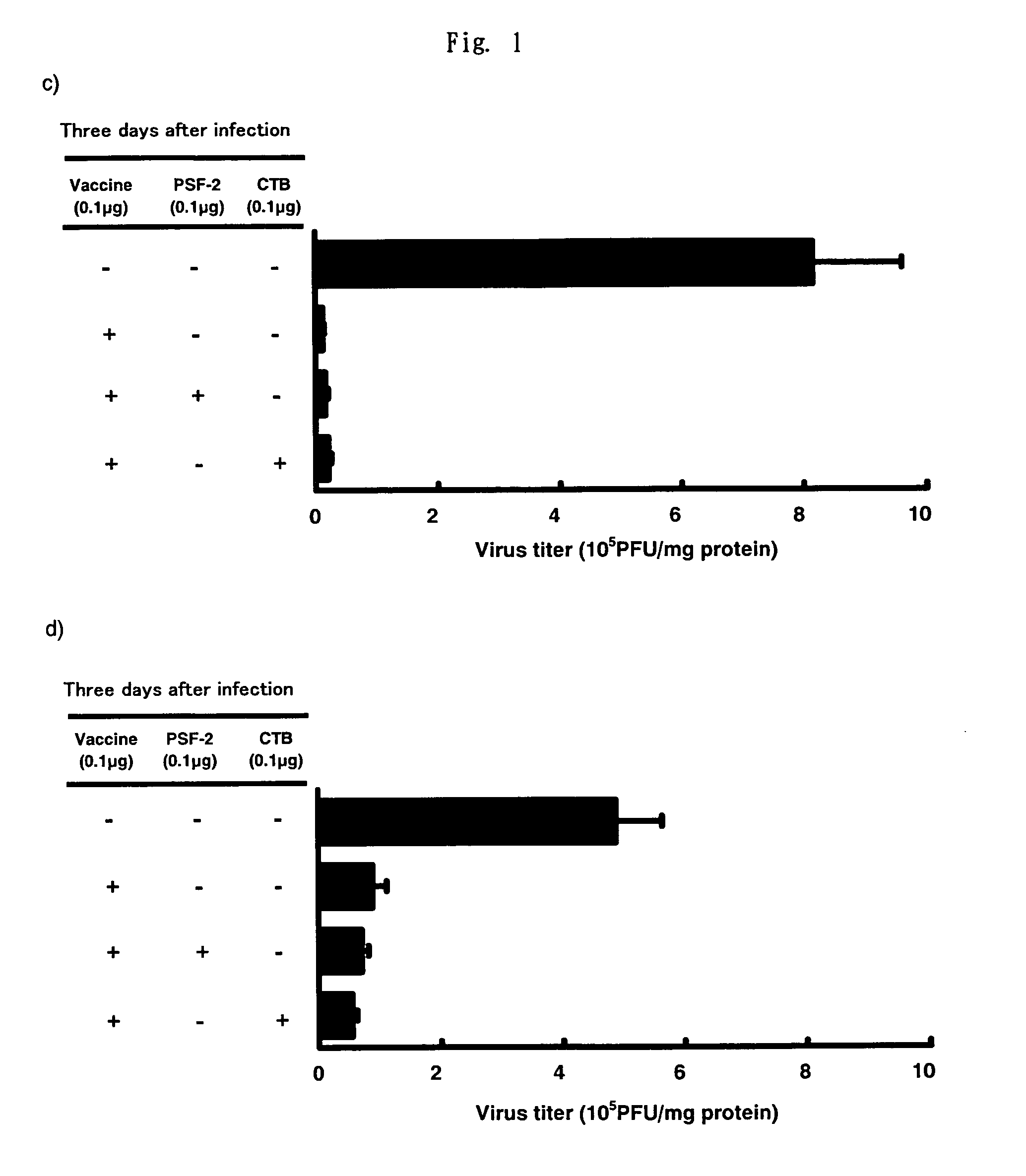Antigen-drug vehicle enabling transmucosal and transdermal administration, and method of inducing mucosal immunity and mucosal vaccine and dds using the same
- Summary
- Abstract
- Description
- Claims
- Application Information
AI Technical Summary
Benefits of technology
Problems solved by technology
Method used
Image
Examples
example 1
Comparison of Nasal Influenza Vaccine and Subcutaneous-Injection Influenza Vaccine on Virus Growth Inhibition Action
[0125] As the nasal vaccine, 0.1 μg of the split-type influenza vaccine was administered to both noses of BALB / c mouse by 1 μl, respectively as a PBS solution, alone or with 0.1 μg of 1-butanol-extracted (excluding SP-A and SP-D) surfactant (PSF-2 below) as the “AD vehicle”, or 0.1 μg of CTB. As the subcutaneous-injection vaccine, the vaccine in the same amount as that of the nasal vaccine was administered as 50 μl PBS solution in total to the hypoderma of the neck of BALB / c mouse, alone or with adding PSF-2 as the AD vehicle or CTB as an adjuvant. After 4 weeks, second immunization was conducted in the same manner as in the first immunization. To the control group, same amount of PBS was administered, respectively. 2 weeks after the second immunization, influenza virus of 6.6×104 PFU was subjected to nasal infection as 3 μl PBS solution. 3 days after the infection, t...
example 2
Influence of PSF-2 or CTB on Production of Anti-Influenza Specific Antibodies (IgA and IgG) in the Washing Solution of the Nasal Cavity After (a) nasal and (b) Subcutaneous-Injection Influenza Vaccine Administration
[0129] In the same manner as described in FIG. 1, as the nasal vaccine, 0.1 μg of the split-type influenza vaccine was administered to both noses of BALB / c mouse by 1 μl, respectively, i.e., 2 μl in total as a PBS solution, alone or with 0.1 μg of PSF-2 as the “AD vehicle”, or 0.1 μg of CTB as an adjuvant. As the subcutaneous vaccine, the vaccine in the same amount as that of the nasal vaccine, PSF-2 or CTB was administered as 50 μl PBS solution to the hypoderma of the neck of BALB / c mouse. After 4 weeks, second immunization was conducted in the same manner as in the first immunization. To the control group, same amount of PBS was administered, respectively. 2 weeks after the second immunization, influenza virus of 6.6×104 PFU was subjected to nasal infection as 3 μl PBS...
example 3
Influence of PSF-2 or CTB on Production of Anti-Influenza Specific Antibodies (IgA and IgG) in the Washing Solution of the Lung by Influenza Vaccine of (a) Nasal Administration and (b) Subcutaneous-Injection
[0131] As the nasal vaccine, 0.1 μg of the split-type influenza vaccine was administered to both noses of BALB / c mouse by 1 μl, respectively, i.e., 2 μl in total as a PBS solution, alone or with 0.1 μg of PSF-2 as the “AD vehicle”, or 0.1 μg of CTB as an adjuvant. As the subcutaneous vaccine, the vaccine in the same amount as that of the nasal vaccine, PSF-2 or CTB was administered as 50 μl PBS solution to the hypoderma of the neck of BALB / c mouse. After 4 weeks, second immunization was conducted in the same manner as in the first immunization. To the control group, same amount of PBS was administered, respectively. 2 weeks after the second immunization, influenza virus of 6.6×104 PFU was subjected to nasal infection as 3 μl PBS solution. 3 days after the infection, the mouse wa...
PUM
| Property | Measurement | Unit |
|---|---|---|
| Hydrophobicity | aaaaa | aaaaa |
| Adsorption entropy | aaaaa | aaaaa |
Abstract
Description
Claims
Application Information
 Login to View More
Login to View More - R&D
- Intellectual Property
- Life Sciences
- Materials
- Tech Scout
- Unparalleled Data Quality
- Higher Quality Content
- 60% Fewer Hallucinations
Browse by: Latest US Patents, China's latest patents, Technical Efficacy Thesaurus, Application Domain, Technology Topic, Popular Technical Reports.
© 2025 PatSnap. All rights reserved.Legal|Privacy policy|Modern Slavery Act Transparency Statement|Sitemap|About US| Contact US: help@patsnap.com



